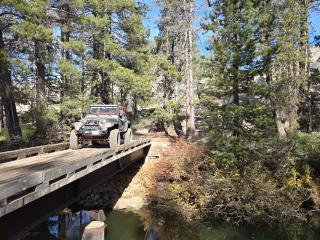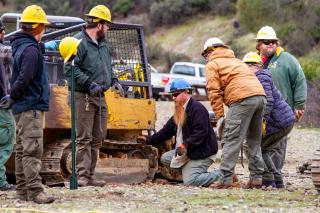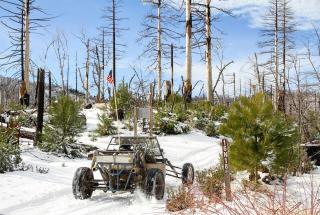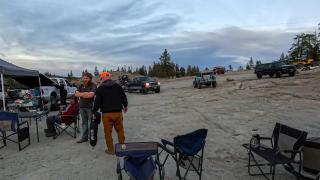
While driving towards mountains and forested areas, have you ever seen Jeeps and trucks that look like they belong at a Monster Truck Rally? Ever wonder where they’re going? These off-road enthusiasts could be heading to your national forests — to rock crawl, get a little mud on the tires, and test their skills and insane builds on Off Highway Vehicle, also known as OHV, trails.
The 18 national forests in California offer hundreds of trails and thousands of miles of wheeled exploration. And according to the nonprofit California Four Wheel Drive Association, more than 8,000 off-roading enthusiasts hit the dirt in the Golden State each weekend. That’s like the whole population of a small town heading out at once.
Many of those off-roading enthusiasts belong to a club, with more than 160 4x4 clubs just in California. One such club, the Joaquin Jeepers from Stockton, in California’s San Joaquin County, is an official nonprofit OHV partner with the Stanislaus National Forest. And while fans of four-wheeling, they’re also interested in keeping public lands open for all off-road hobbyists.
Aaron James, a partnership and outreach coordinator with the Stanislaus National Forest, described how they group 4x4 enthusiasts with OHVs.
“It's really under the umbrella of motorized recreation and motorized trails. We use the terms OHV and 4x4 off-road universally, even though there are significant differences,” he explained. “An off-highway vehicle is technically something that wouldn't be street legal. A 4x4 could be a Toyota RAV4 [a mid-sized sport utility vehicle] with a device called a 4x4 shifter in it that allows it to shift into four-wheel drive.”
The OHV category contains its own insider language with unique names for the vehicles, including side-by-sides, UTVs, Razors, Polaris, dirt bikes, ATVs and quads.

Clean before you crawl
As an official partner, the Joaquin Jeepers help manage their 3.5-mile-long Slick Rock trail, also known as Forest Route 7N17.
“We’re picking up trash if people have not packed out what they packed in,” said 30-year club veteran Todd Troglin, an engineer tech for an irrigation district. He rides a 2005 Jeep LJ Rubicon, nicknamed Tow Truck 2.
Along the trail there is a club-built bridge and nearby, a small area for dispersed camping with a few fire rings.
“We’ll inspect the fire rings and at certain areas, we will check to make sure everyone’s staying on the trail,” Todd continued. “Every once in a while, somebody will try and make a new path. They'll see a big boulder they want to try and climb. We block those areas off by dragging a downed tree or boulder across the path, so other people don't follow those tracks.”
While riding through the heavily forested areas, Todd pointed out evidence of the club’s efforts to clear fallen trees. Off-road clubs often help with removing hazardous trees, maintaining a possible fuel break for a wildfire response, and assisting search and rescue teams.
They are the eyes on the ground on trails and backcountry areas, alerting land managers and law enforcement to danger.

“We try and be the first ones on the trail, as soon as the Forest Service determines the snow is gone and opens the gates. Once we get the word, that’s when removing those trees that are blocking the path becomes our goal. Because it prevents people from going off trail to go around those obstacles,” said Todd.
At nearly 7,000 feet, Slick Rock offers two access points to even get to the trailheads. Both are guarded by locked gates, with seasonal opening and closing dates of April 15 and December 15.
“Those gates get closed December 15 based on our travel management rule. Even if there is no snow on the ground come December 15, by law, we are supposed to keep those gates closed,” James said. “And, come April 15… we keep it closed until the snow melts off.”
Keeping the gates closed until the snow melts is intended to keep drivers safe and to protect the trails. Once snow melts, the water tends to pool and needs time to be absorbed into the soil or evaporate. If you run tires through that ground too early, it creates depressions in the ground and unnatural runoff.
James points out there are also important meadows, wildlife habitats, and alpine creeks along Forest Road 7N17.

OHV view of the landscape
At the most beautiful viewing area of the Slick Rock trail, the ride parallels Silver Creek, which cascades down giant smooth granite slabs. One section even creates seemingly the perfect driveway into the Carson-Iceberg Wilderness. But, as the Wilderness Act of 1964 explains, people cannot operate motorized vehicles within designed wilderness areas. The club has seen people drive across to explore that protected area and want to deter that misuse.
“That is a major problem, and it really does ruin the whole spirit of the wilderness,” said James.
Having outdoor and trail ambassadors like the Joaquin Jeepers and other responsible 4x4 enthusiasts lead by example is one of the best ways to deter bad behavior. They come from the same recreational community. They care to keep these trails and public lands open. So, they can have an open dialogue with folks.
The coming together as a community, a force of one, is one of the core values of the clubs.

“The Forest Service is here to manage the land. We need the public to tell us what their priorities are. The easiest way to do that is to get involved with what we do,” said James. “Join a club or group or start your own. It goes a long way for us to be able to work with folks like that, to collaborate on projects.”
“I have been coming here a long time. I’ve had my children and stepchildren here over the years,” Todd added. “We have the younger drivers out here with the club. We even have fathers and sons riding together. So, our whole advocacy is to use it responsibly, so it can be used by many people in the future, for many generations.”





